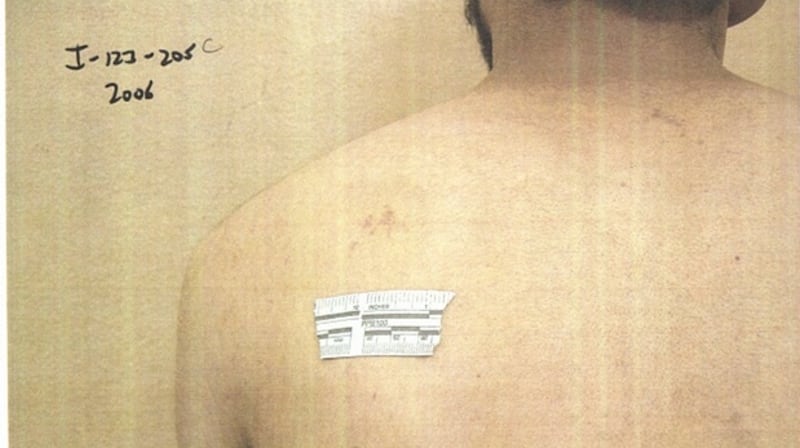Bruises, reddened marks and bandaged body parts featured in nearly 200 images of US detainee abuse that the Pentagon was forced to release on Friday, the result of a court battle that has lasted more than a decade.
While the American Civil Liberties Union - which has fought for the publication of the photos of Bush-era torture in Iraq and Afghanistan since October 2003 - hailed the belated disclosure, it pledged to keep fighting for approximately 1,800 more images the Pentagon continues to withhold, which it believes documents far more graphic detainee torture.
The photos are part of a cache relevant to investigations of detainee abuse at two dozen US military sites around Iraq and Afghanistan, and perhaps Guantánamo Bay.

Many showed detainees in states of undress having their bodies inspected, with rulers and coins held up for comparison and placement of injuries.
In November, Ashton Carter, the US defence secretary, cleared the way to release 198 of the images after a federal judge rejected longstanding government attempts to suppress the entire cache.
In allowing the release of the photos, Mr Carter has reversed the decisions of two of his Pentagon predecessors and a bevy of senior military officers over the years. Nevertheless, the ACLU called the release insufficient, selective and indicative of a cover-up of detainee abuse stretching across the Bush and Obama administrations.
"It's most likely the case that these are the most innocuous of the photos, and if that's true, it's a shadow of meaningful transparency," said Alex Abdo, an ACLU attorney who has worked on the photo litigation since 2005.
The photos appeared de-contextualized, without indication of what specific abuses investigators inspected, where detainees were held, or under what circumstances.
Several photos were grainy, showing sections of the body where detainees alleged US troops harmed them, without showing a person in full. Several images displayed detainees’ legs, backs, feet and occasionally their heads, though the head photographs did not show visible contusions.
None of the photographs showed a detained man’s face without obstruction.
A Pentagon statement accompanying the photos said that the investigations they supported had resulted in 14 substantiated allegations, from which “65 service members received some form of disciplinary action”, ranging from letters of reprimand to life imprisonment.
While a full accounting of what the photos show remains elusive, the ACLU believes that among the still-suppressed photos are imagery of a female soldier sexually abusing a detainee with a broomstick; an Iraqi civilian farmer executed by US troops while his hands were tied behind his back; and autopsy photos of an Afghan detainee known as Dilawar, whose death was the subject of Alex Gibney’s acclaimed 2007 documentary Taxi to the Dark Side.
Since the ACLU first sought the photos in the wake of the international outcry over US torture at Iraq’s Abu Ghraib prison, a wall of US government resistance had long held firm.
Famously, in May 2009, president Barack Obama reversed his position on the photograph’s release in May 2009, and ordered the photos to remain hidden, contending they would “further inflame anti-American opinion” if released.
Later that year, Congress passed the Protected National Security Documents Act, to suppress any Bush-era photographs of detainees in military custody unless the defence secretary could vouch that their release would have minimal consequences for US troops.
Breakthrough
But the ACLU won a breakthrough in 2014 after a decade of litigation. A federal judge in New York, Alvin Hellerstein, rejected the government's desired blanket ban on the photos in 2014 and required the Pentagon to individually certify images it considered harmful to national security and explain its reasoning.
After viewing some of the photographs privately, Mr Hellerstein said in August 2014 that some of them were “relatively innocuous while others need more serious consideration”.
Mr Hellerstein's assessment contradicted two defence secretaries, Robert Gates and Leon Panetta, as well as US marine generals James Mattis and John Allen, all of whom certified that the wholesale release of the detainee photo trove would "endanger citizens of the United States, members of the United States armed forces, or employees of the United States Government deployed outside the United States".
A Pentagon statement said that senior military commanders were consulted before the release, and pledged the military to ensuring “the safe, lawful, and humane treatment of individuals in US custody in the context of armed conflicts, consistent with the treaty obligations of the United States, including the Geneva Conventions”.
The ACLU's Abdo cited the case of Eric Garner, whose choking death by New York police was filmed and distributed on social media, as a testament to the unique power of imagery to galvanize change and drive calls for justice.
“We think the photos, when released, have the ability to do the same for accountability for the abuse of detainees, and I think the Pentagon knows it, too,” Mr Abdo said.
The Guardian








